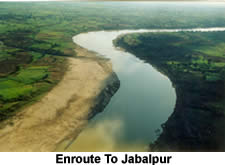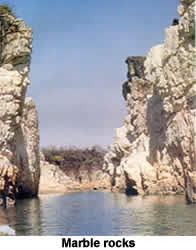
Dimdima
Online Children's Magazine from India

Dimdima
Online Children's Magazine from India

A few kilometres before the river reaches Jabalpur, the second largest of Madhya Pradesh’s cities, it meanders through a stretch of gigantic marble rocks, called Bhedaghat. The place got its name because of its resemblance to bhed or sheep, or as some say because of its location at the bhed or confluence of the Bavan and the Narmada. The reflection of the gleaming white (and sometimes pink, brown and black) magnesium limestone rocks in the crystal clear water of the Narmada is fascinating, especially by moonlight.
Amongst the interesting rock formations here are Haathi ka Paon, that resemble the footprints of an elephant and Hiran Kunch that resembles a deer. There’s also the rock upon which Hanuman is believed to have set his foot on his way to Lanka. An interesting pastime of the tourists is to guess the shape of the rocks from their shadows on the river’s placid waters.
 The Narmada making its way through these rocks narrows down and then takes a sharp plunge, forming the famous Dhuandhar Falls or ‘Smoke Cascade’. So powerful is the plunge that its roar can be heard from miles away.
The Narmada making its way through these rocks narrows down and then takes a sharp plunge, forming the famous Dhuandhar Falls or ‘Smoke Cascade’. So powerful is the plunge that its roar can be heard from miles away.
Most people in Bhedaghat are sculptors, who make a living fashioning the marble quarried locally or the soapstone got from the river, into gods, goddesses, lingams, crosses, ashtrays and trinket boxes. Tourists get their names carved out on soapstone to take back with them as mementoes.
There are two theories on how Jabalpur got its name. One is that it was named after the saint, Jabali, and the other is that it got its name from the surrounding rock-bearing hills, known as jabal in Persian. Jabalpur was once the pleasure resort of the Gond rulers. The Madan Mahal is a palace on a hilltop 5km away. It was built by Madan Shah, one of the most powerful Gond kings who ruled in the 12th century, when the Gond empire was at its zenith. The Gond queen, Rani Durgavati, bravely tried to defend it against the Mughal invasion, and on the verge of losing the battle, she stabbed herself to death on the banks of the river. Jabalpur was later the capital of the Kalachuri kings and then the Marathas, until the British seized it in 1817. Thereafter it has been an important military and manufacturing centre.
| Dinosaurs roamed along the Narmada Valley once. One of the earliest and largest tyrannosaur fossils ever found in the world, was excavated near Jabalpur. It is now in the British Museum of Natural History. Apart from this, fossils of twelve different dinosaur have been unearthed in the Jabalpur-Mandla region. |
Last updated on :12/5/2005
Dimdima is the Sanskrit word for ‘drumbeat’. In olden days, victory in battle was heralded by the beat of drums or any important news to be conveyed to the people used to be accompanied with drumbeats.
Bharatiya Vidya Bhavan
K. M Munshi Marg,
Chowpatty, Mumbai - 400 007
email : editor@dimdima.com
Bharatiya Vidya Bhavan
505, Sane Guruji Marg,
Tardeo, Mumbai - 400 034
email : promo@dimdima.com
Dimdima.com, the Children's Website of Bharatiya Vidya Bhavan launched in 2000 and came out with a Printed version of Dimdima Magazine in 2004. At present the Printed Version have more than 35,000 subscribers from India and Abroad.